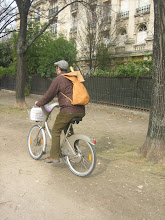I think we need to think of the cuts of a beef, pork, lamb, chicken, etc as what they are, parts of a living, breathing animal. What does this mean?
If a part of an animal works hard, such as the legs it walks on or the belly that holds in all its innards...these are strong, tough items and they may need a bit more Tender Loving Care to make them Tender and Loving to Eat. If a cut of meat gets no workout all day, such as the tenderloin protecting the spinal column, then it will start out very tender...but watch out...as quickly as it starts tender it can become the most hard and unfriendly piece of meat you ever tried.
Why is this??? The more tender cuts of meat from the tenderloin, rib roast, etc..have less connective tissue and sinews, where as the hard working muscles of the legs, shoulders, belly, etc...have tougher, more dense strands of muscle. Just think of what happens when you go for a long run and feel those calve muscles ( shanks in cookin terms)...lots of tension due to lots of hard work. Even more so is the strongest muscle of all, the heart, pumping all day long for a life time. If you ever have a chance to cook one you will realize the density and darkness of this muscle mass ( and yes the darker the meat the more tlc it may need...this is not some issue of it being filled with blood and such...its due to use. The non flying chicken walks on its legs, but the duck can fly...this is one reason a duck breast is much darker than a chicken breast...but I digress)
Please check out the bottom of the blog for the little chart "THE MEAT SHEET" that I made which I hope will help clarify your meat selections at the butchers counter next time you are there. I have tried to simply organize all the major cuts of meat into categories of cooking as follows...
HIGH AND DRY: grilling, broiling, pan frying techniques that are cooked rather quickly at high and dry heat. High is the temperature, and dry means it is not cooked in a liquid. These cuts usually are not in need of marinades to tenderize, but of course you can do so for flavour purposes, but often the dry rub of spices works wonderfully on these cuts.
ROASTS: Longer cooking techniques, often on a high heat to start ( whether initially seared in a pan, high heat in your oven, or on the hot part of your bbq) but then once your initial browning/searing has occurred its time to lower the heat ( in oven or cooler section of your bbq) and let the meat slowly cook to the temp you desire.
SLOW AND LOW: my favorite...braising time...check out the lamb shoulder blog entry from last month for an example. but this is a slow cooking of a tough ( and usually cheap) cut of meat in a liquid until so tender and succulent that you would think there was never a need to invent the knife.
QUICK TIPS:
1. Relax. Sounds simple, but every time you move your steak around on the grill, keep turning your browning short ribs in the pan, all you are doing is slowing down the meats efforts to get a good sear and cook itself. So the golden rule on the grill for example when cooking a nice steak...season it liberally with salt and pepper, clean your very hot grill, and set the steak down...after two minutes turn it 90degrees...in two more minutes flip it, in two more minutes turn again 90 degrees...more time between each turn for more well done, less time for more rare. The idea is getting some good char marks. Same goes for a piece of fish in a pan...please stop the endless shaking of the pan for 5 straight minutes, it does not help...simply make sure the fish does not stick and then relax...
2 REST. Again sounds simple, but everyone sees food come off the grill and wants to eat it...STOP . Let the meat ( any meat, fish , bird, etc..) rest for 5 minutes to redistribute the heat and juices. You do this with your turkey for thanksgiving, why don't you do it each and every other time you eat...
3. REWARD YOURSELF. Remember that the act of eating is not simply about physical nourishment, and each and every time you cook for friends and family you should remember how important this simple act is for you and those around you...the friends, the farmers, the grocers, the ranchers, the list goes on and on...but truth is that you are never cooking alone...so cheers to you!!!



where is the meat sheet?
ReplyDeleteYou gotta head to the absolute bottom of the blog itself in order to view the MEAT SHEET
ReplyDelete